Maternal Healthcare Program: Addressing Infant Mortality Disparities
VerifiedAdded on 2023/03/29
|7
|1637
|376
Project
AI Summary
This project outlines a healthcare administration program designed to mitigate high infant mortality rates among African-American communities. It addresses the problem of significant disparities compared to White populations, influenced by socioeconomic status, health behaviors, and education levels. The program aims to enhance health literacy and promote positive health practices among African-American mothers through education and advocacy. The proposal includes an annotated bibliography of five peer-reviewed articles providing evidence for the program's rationale, focusing on socioeconomic factors, breastfeeding practices, and preterm birth disparities. The target audience includes healthcare executives, advocacy groups, and African-American clients, with the goal of improving healthcare access and outcomes.
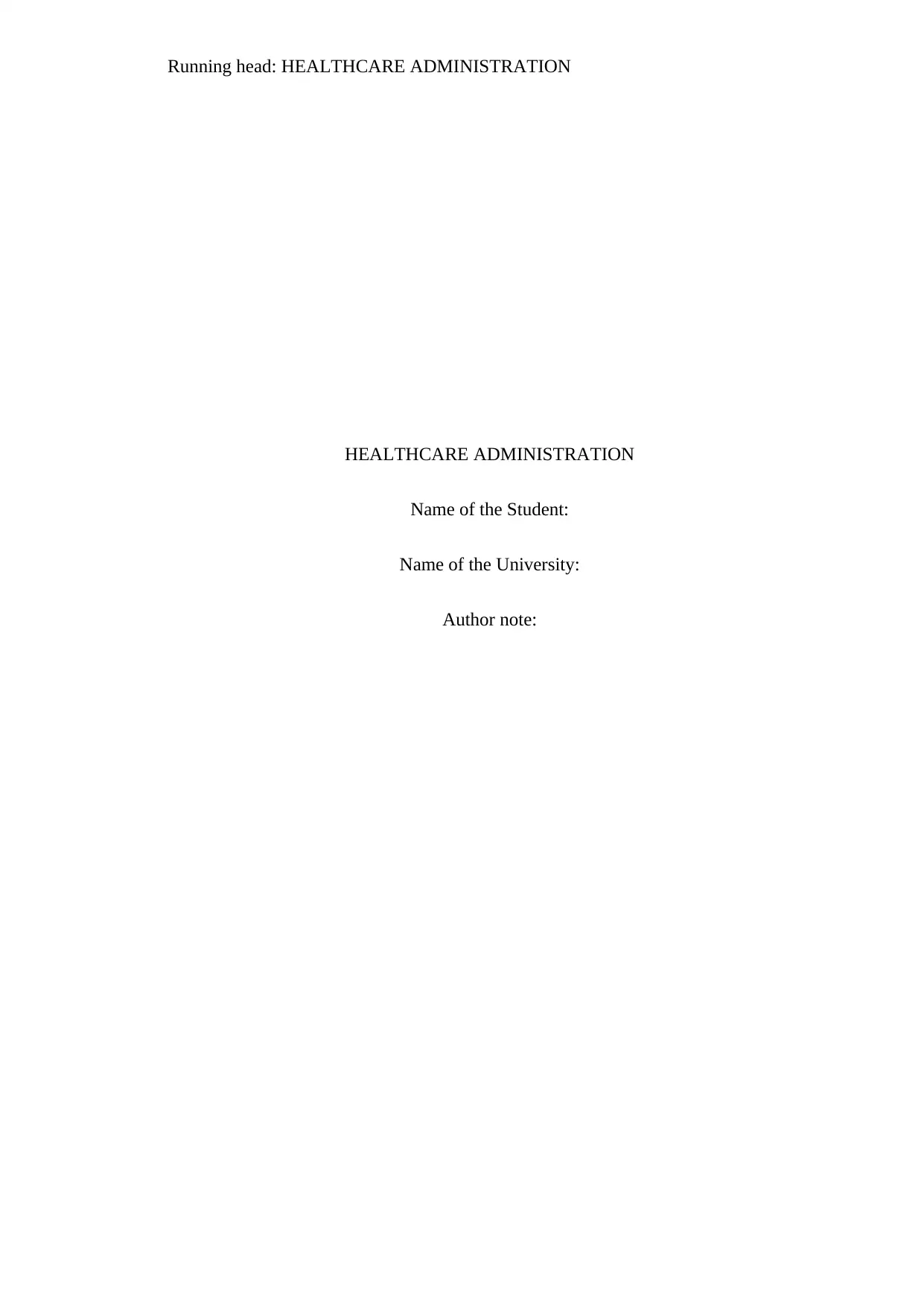
Running head: HEALTHCARE ADMINISTRATION
HEALTHCARE ADMINISTRATION
Name of the Student:
Name of the University:
Author note:
HEALTHCARE ADMINISTRATION
Name of the Student:
Name of the University:
Author note:
Paraphrase This Document
Need a fresh take? Get an instant paraphrase of this document with our AI Paraphraser
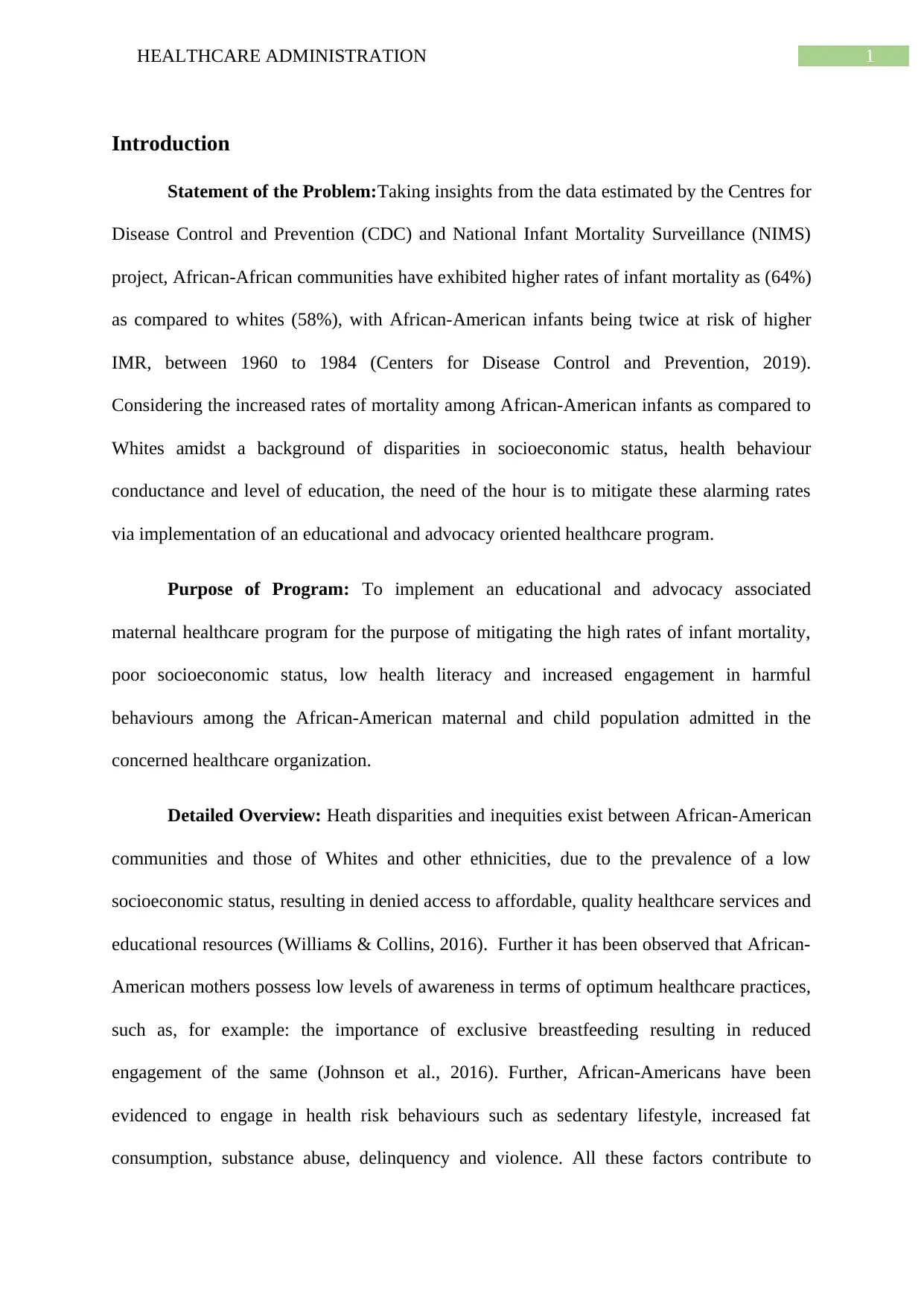
1HEALTHCARE ADMINISTRATION
Introduction
Statement of the Problem:Taking insights from the data estimated by the Centres for
Disease Control and Prevention (CDC) and National Infant Mortality Surveillance (NIMS)
project, African-African communities have exhibited higher rates of infant mortality as (64%)
as compared to whites (58%), with African-American infants being twice at risk of higher
IMR, between 1960 to 1984 (Centers for Disease Control and Prevention, 2019).
Considering the increased rates of mortality among African-American infants as compared to
Whites amidst a background of disparities in socioeconomic status, health behaviour
conductance and level of education, the need of the hour is to mitigate these alarming rates
via implementation of an educational and advocacy oriented healthcare program.
Purpose of Program: To implement an educational and advocacy associated
maternal healthcare program for the purpose of mitigating the high rates of infant mortality,
poor socioeconomic status, low health literacy and increased engagement in harmful
behaviours among the African-American maternal and child population admitted in the
concerned healthcare organization.
Detailed Overview: Heath disparities and inequities exist between African-American
communities and those of Whites and other ethnicities, due to the prevalence of a low
socioeconomic status, resulting in denied access to affordable, quality healthcare services and
educational resources (Williams & Collins, 2016). Further it has been observed that African-
American mothers possess low levels of awareness in terms of optimum healthcare practices,
such as, for example: the importance of exclusive breastfeeding resulting in reduced
engagement of the same (Johnson et al., 2016). Further, African-Americans have been
evidenced to engage in health risk behaviours such as sedentary lifestyle, increased fat
consumption, substance abuse, delinquency and violence. All these factors contribute to
Introduction
Statement of the Problem:Taking insights from the data estimated by the Centres for
Disease Control and Prevention (CDC) and National Infant Mortality Surveillance (NIMS)
project, African-African communities have exhibited higher rates of infant mortality as (64%)
as compared to whites (58%), with African-American infants being twice at risk of higher
IMR, between 1960 to 1984 (Centers for Disease Control and Prevention, 2019).
Considering the increased rates of mortality among African-American infants as compared to
Whites amidst a background of disparities in socioeconomic status, health behaviour
conductance and level of education, the need of the hour is to mitigate these alarming rates
via implementation of an educational and advocacy oriented healthcare program.
Purpose of Program: To implement an educational and advocacy associated
maternal healthcare program for the purpose of mitigating the high rates of infant mortality,
poor socioeconomic status, low health literacy and increased engagement in harmful
behaviours among the African-American maternal and child population admitted in the
concerned healthcare organization.
Detailed Overview: Heath disparities and inequities exist between African-American
communities and those of Whites and other ethnicities, due to the prevalence of a low
socioeconomic status, resulting in denied access to affordable, quality healthcare services and
educational resources (Williams & Collins, 2016). Further it has been observed that African-
American mothers possess low levels of awareness in terms of optimum healthcare practices,
such as, for example: the importance of exclusive breastfeeding resulting in reduced
engagement of the same (Johnson et al., 2016). Further, African-Americans have been
evidenced to engage in health risk behaviours such as sedentary lifestyle, increased fat
consumption, substance abuse, delinquency and violence. All these factors contribute to
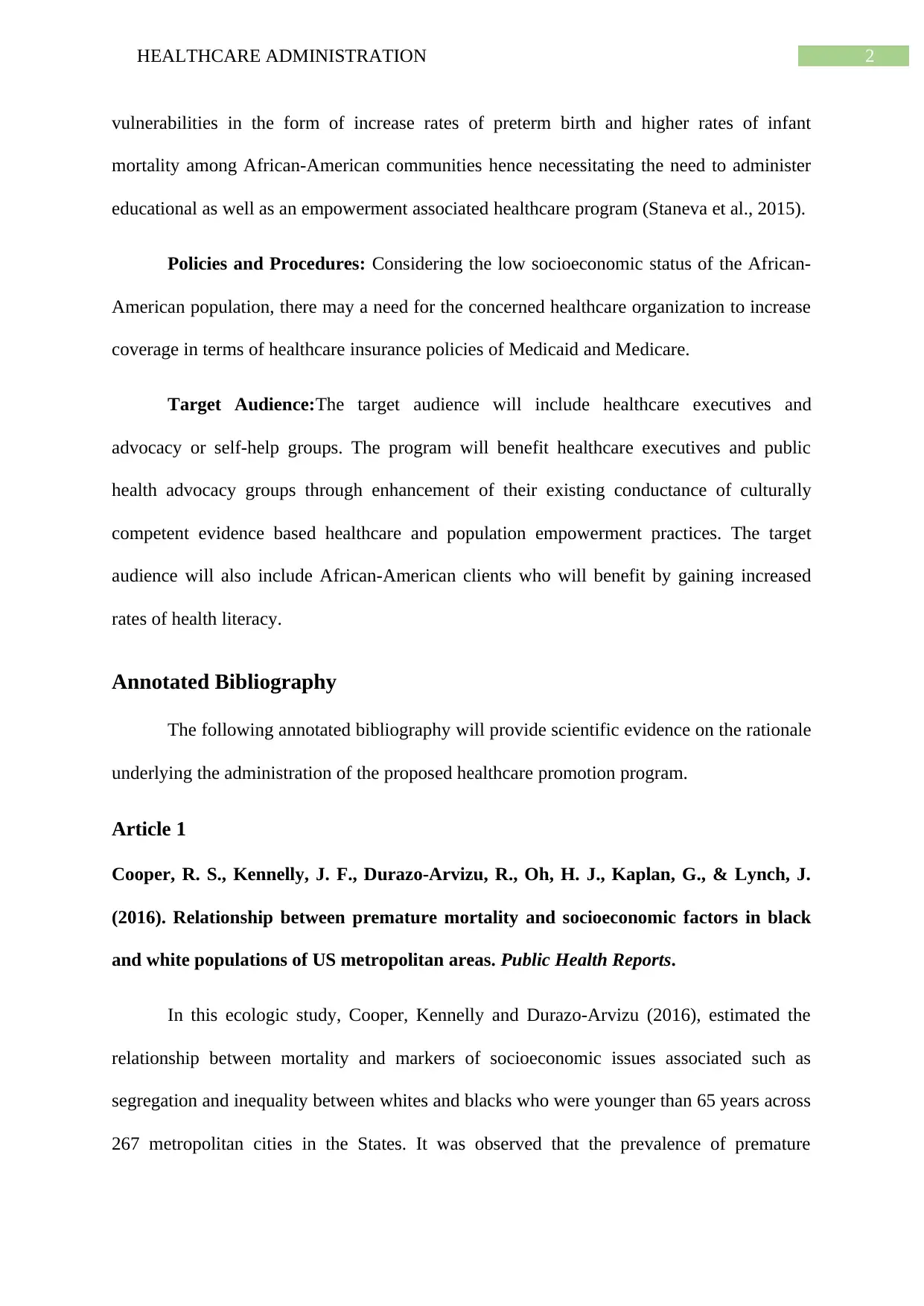
2HEALTHCARE ADMINISTRATION
vulnerabilities in the form of increase rates of preterm birth and higher rates of infant
mortality among African-American communities hence necessitating the need to administer
educational as well as an empowerment associated healthcare program (Staneva et al., 2015).
Policies and Procedures: Considering the low socioeconomic status of the African-
American population, there may a need for the concerned healthcare organization to increase
coverage in terms of healthcare insurance policies of Medicaid and Medicare.
Target Audience:The target audience will include healthcare executives and
advocacy or self-help groups. The program will benefit healthcare executives and public
health advocacy groups through enhancement of their existing conductance of culturally
competent evidence based healthcare and population empowerment practices. The target
audience will also include African-American clients who will benefit by gaining increased
rates of health literacy.
Annotated Bibliography
The following annotated bibliography will provide scientific evidence on the rationale
underlying the administration of the proposed healthcare promotion program.
Article 1
Cooper, R. S., Kennelly, J. F., Durazo-Arvizu, R., Oh, H. J., Kaplan, G., & Lynch, J.
(2016). Relationship between premature mortality and socioeconomic factors in black
and white populations of US metropolitan areas. Public Health Reports.
In this ecologic study, Cooper, Kennelly and Durazo-Arvizu (2016), estimated the
relationship between mortality and markers of socioeconomic issues associated such as
segregation and inequality between whites and blacks who were younger than 65 years across
267 metropolitan cities in the States. It was observed that the prevalence of premature
vulnerabilities in the form of increase rates of preterm birth and higher rates of infant
mortality among African-American communities hence necessitating the need to administer
educational as well as an empowerment associated healthcare program (Staneva et al., 2015).
Policies and Procedures: Considering the low socioeconomic status of the African-
American population, there may a need for the concerned healthcare organization to increase
coverage in terms of healthcare insurance policies of Medicaid and Medicare.
Target Audience:The target audience will include healthcare executives and
advocacy or self-help groups. The program will benefit healthcare executives and public
health advocacy groups through enhancement of their existing conductance of culturally
competent evidence based healthcare and population empowerment practices. The target
audience will also include African-American clients who will benefit by gaining increased
rates of health literacy.
Annotated Bibliography
The following annotated bibliography will provide scientific evidence on the rationale
underlying the administration of the proposed healthcare promotion program.
Article 1
Cooper, R. S., Kennelly, J. F., Durazo-Arvizu, R., Oh, H. J., Kaplan, G., & Lynch, J.
(2016). Relationship between premature mortality and socioeconomic factors in black
and white populations of US metropolitan areas. Public Health Reports.
In this ecologic study, Cooper, Kennelly and Durazo-Arvizu (2016), estimated the
relationship between mortality and markers of socioeconomic issues associated such as
segregation and inequality between whites and blacks who were younger than 65 years across
267 metropolitan cities in the States. It was observed that the prevalence of premature
⊘ This is a preview!⊘
Do you want full access?
Subscribe today to unlock all pages.

Trusted by 1+ million students worldwide
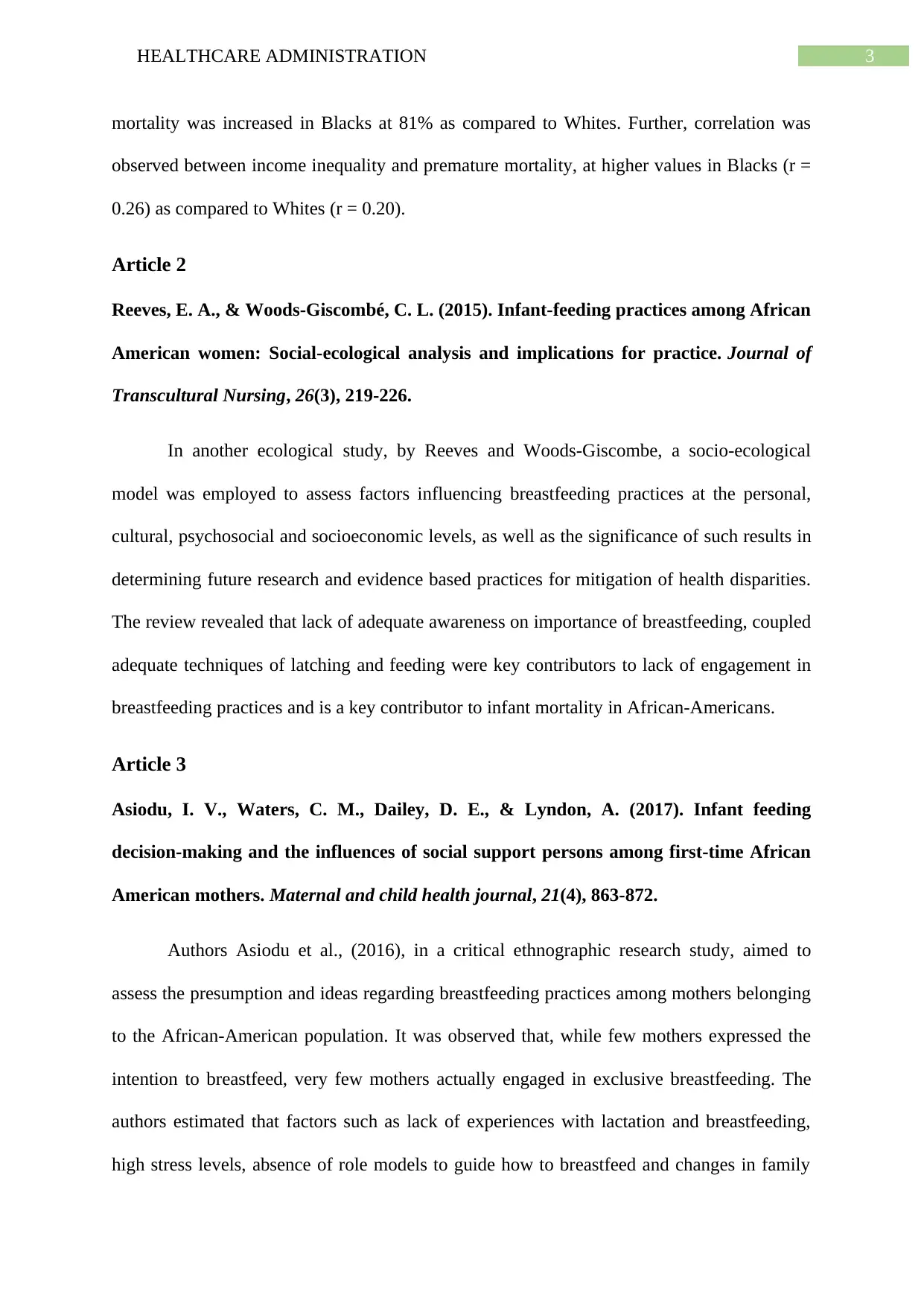
3HEALTHCARE ADMINISTRATION
mortality was increased in Blacks at 81% as compared to Whites. Further, correlation was
observed between income inequality and premature mortality, at higher values in Blacks (r =
0.26) as compared to Whites (r = 0.20).
Article 2
Reeves, E. A., & Woods-Giscombé, C. L. (2015). Infant-feeding practices among African
American women: Social-ecological analysis and implications for practice. Journal of
Transcultural Nursing, 26(3), 219-226.
In another ecological study, by Reeves and Woods-Giscombe, a socio-ecological
model was employed to assess factors influencing breastfeeding practices at the personal,
cultural, psychosocial and socioeconomic levels, as well as the significance of such results in
determining future research and evidence based practices for mitigation of health disparities.
The review revealed that lack of adequate awareness on importance of breastfeeding, coupled
adequate techniques of latching and feeding were key contributors to lack of engagement in
breastfeeding practices and is a key contributor to infant mortality in African-Americans.
Article 3
Asiodu, I. V., Waters, C. M., Dailey, D. E., & Lyndon, A. (2017). Infant feeding
decision-making and the influences of social support persons among first-time African
American mothers. Maternal and child health journal, 21(4), 863-872.
Authors Asiodu et al., (2016), in a critical ethnographic research study, aimed to
assess the presumption and ideas regarding breastfeeding practices among mothers belonging
to the African-American population. It was observed that, while few mothers expressed the
intention to breastfeed, very few mothers actually engaged in exclusive breastfeeding. The
authors estimated that factors such as lack of experiences with lactation and breastfeeding,
high stress levels, absence of role models to guide how to breastfeed and changes in family
mortality was increased in Blacks at 81% as compared to Whites. Further, correlation was
observed between income inequality and premature mortality, at higher values in Blacks (r =
0.26) as compared to Whites (r = 0.20).
Article 2
Reeves, E. A., & Woods-Giscombé, C. L. (2015). Infant-feeding practices among African
American women: Social-ecological analysis and implications for practice. Journal of
Transcultural Nursing, 26(3), 219-226.
In another ecological study, by Reeves and Woods-Giscombe, a socio-ecological
model was employed to assess factors influencing breastfeeding practices at the personal,
cultural, psychosocial and socioeconomic levels, as well as the significance of such results in
determining future research and evidence based practices for mitigation of health disparities.
The review revealed that lack of adequate awareness on importance of breastfeeding, coupled
adequate techniques of latching and feeding were key contributors to lack of engagement in
breastfeeding practices and is a key contributor to infant mortality in African-Americans.
Article 3
Asiodu, I. V., Waters, C. M., Dailey, D. E., & Lyndon, A. (2017). Infant feeding
decision-making and the influences of social support persons among first-time African
American mothers. Maternal and child health journal, 21(4), 863-872.
Authors Asiodu et al., (2016), in a critical ethnographic research study, aimed to
assess the presumption and ideas regarding breastfeeding practices among mothers belonging
to the African-American population. It was observed that, while few mothers expressed the
intention to breastfeed, very few mothers actually engaged in exclusive breastfeeding. The
authors estimated that factors such as lack of experiences with lactation and breastfeeding,
high stress levels, absence of role models to guide how to breastfeed and changes in family
Paraphrase This Document
Need a fresh take? Get an instant paraphrase of this document with our AI Paraphraser
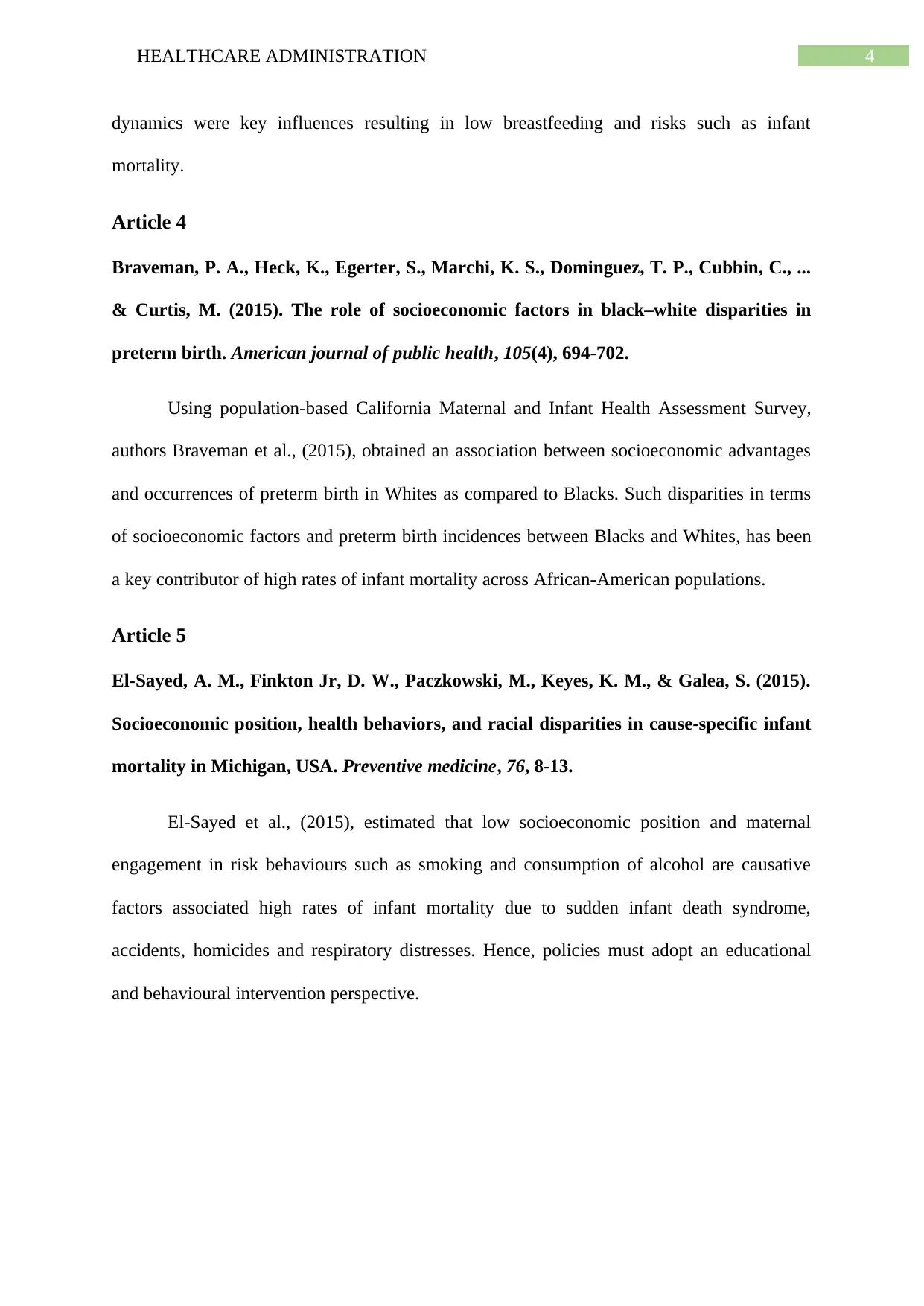
4HEALTHCARE ADMINISTRATION
dynamics were key influences resulting in low breastfeeding and risks such as infant
mortality.
Article 4
Braveman, P. A., Heck, K., Egerter, S., Marchi, K. S., Dominguez, T. P., Cubbin, C., ...
& Curtis, M. (2015). The role of socioeconomic factors in black–white disparities in
preterm birth. American journal of public health, 105(4), 694-702.
Using population-based California Maternal and Infant Health Assessment Survey,
authors Braveman et al., (2015), obtained an association between socioeconomic advantages
and occurrences of preterm birth in Whites as compared to Blacks. Such disparities in terms
of socioeconomic factors and preterm birth incidences between Blacks and Whites, has been
a key contributor of high rates of infant mortality across African-American populations.
Article 5
El-Sayed, A. M., Finkton Jr, D. W., Paczkowski, M., Keyes, K. M., & Galea, S. (2015).
Socioeconomic position, health behaviors, and racial disparities in cause-specific infant
mortality in Michigan, USA. Preventive medicine, 76, 8-13.
El-Sayed et al., (2015), estimated that low socioeconomic position and maternal
engagement in risk behaviours such as smoking and consumption of alcohol are causative
factors associated high rates of infant mortality due to sudden infant death syndrome,
accidents, homicides and respiratory distresses. Hence, policies must adopt an educational
and behavioural intervention perspective.
dynamics were key influences resulting in low breastfeeding and risks such as infant
mortality.
Article 4
Braveman, P. A., Heck, K., Egerter, S., Marchi, K. S., Dominguez, T. P., Cubbin, C., ...
& Curtis, M. (2015). The role of socioeconomic factors in black–white disparities in
preterm birth. American journal of public health, 105(4), 694-702.
Using population-based California Maternal and Infant Health Assessment Survey,
authors Braveman et al., (2015), obtained an association between socioeconomic advantages
and occurrences of preterm birth in Whites as compared to Blacks. Such disparities in terms
of socioeconomic factors and preterm birth incidences between Blacks and Whites, has been
a key contributor of high rates of infant mortality across African-American populations.
Article 5
El-Sayed, A. M., Finkton Jr, D. W., Paczkowski, M., Keyes, K. M., & Galea, S. (2015).
Socioeconomic position, health behaviors, and racial disparities in cause-specific infant
mortality in Michigan, USA. Preventive medicine, 76, 8-13.
El-Sayed et al., (2015), estimated that low socioeconomic position and maternal
engagement in risk behaviours such as smoking and consumption of alcohol are causative
factors associated high rates of infant mortality due to sudden infant death syndrome,
accidents, homicides and respiratory distresses. Hence, policies must adopt an educational
and behavioural intervention perspective.
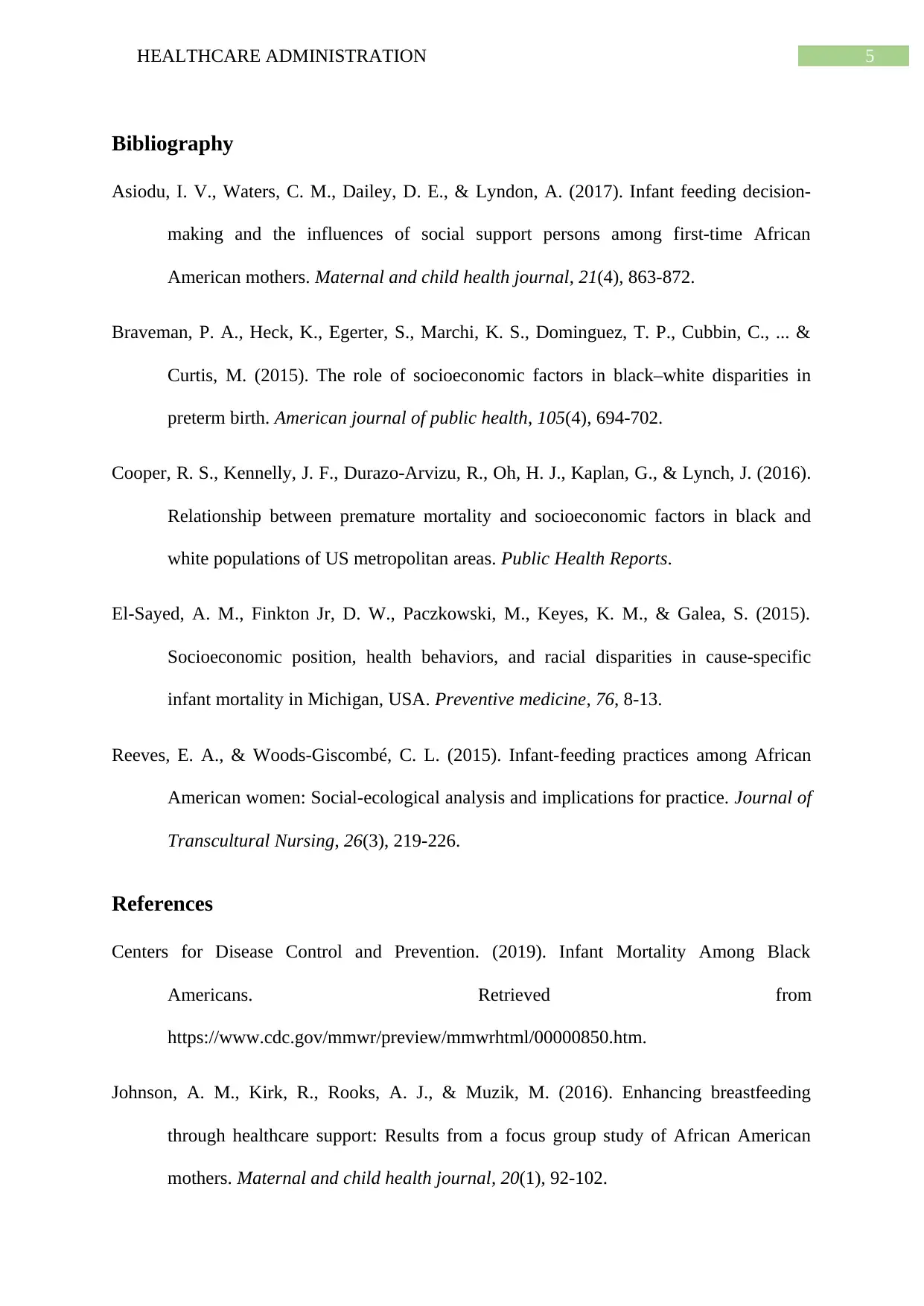
5HEALTHCARE ADMINISTRATION
Bibliography
Asiodu, I. V., Waters, C. M., Dailey, D. E., & Lyndon, A. (2017). Infant feeding decision-
making and the influences of social support persons among first-time African
American mothers. Maternal and child health journal, 21(4), 863-872.
Braveman, P. A., Heck, K., Egerter, S., Marchi, K. S., Dominguez, T. P., Cubbin, C., ... &
Curtis, M. (2015). The role of socioeconomic factors in black–white disparities in
preterm birth. American journal of public health, 105(4), 694-702.
Cooper, R. S., Kennelly, J. F., Durazo-Arvizu, R., Oh, H. J., Kaplan, G., & Lynch, J. (2016).
Relationship between premature mortality and socioeconomic factors in black and
white populations of US metropolitan areas. Public Health Reports.
El-Sayed, A. M., Finkton Jr, D. W., Paczkowski, M., Keyes, K. M., & Galea, S. (2015).
Socioeconomic position, health behaviors, and racial disparities in cause-specific
infant mortality in Michigan, USA. Preventive medicine, 76, 8-13.
Reeves, E. A., & Woods-Giscombé, C. L. (2015). Infant-feeding practices among African
American women: Social-ecological analysis and implications for practice. Journal of
Transcultural Nursing, 26(3), 219-226.
References
Centers for Disease Control and Prevention. (2019). Infant Mortality Among Black
Americans. Retrieved from
https://www.cdc.gov/mmwr/preview/mmwrhtml/00000850.htm.
Johnson, A. M., Kirk, R., Rooks, A. J., & Muzik, M. (2016). Enhancing breastfeeding
through healthcare support: Results from a focus group study of African American
mothers. Maternal and child health journal, 20(1), 92-102.
Bibliography
Asiodu, I. V., Waters, C. M., Dailey, D. E., & Lyndon, A. (2017). Infant feeding decision-
making and the influences of social support persons among first-time African
American mothers. Maternal and child health journal, 21(4), 863-872.
Braveman, P. A., Heck, K., Egerter, S., Marchi, K. S., Dominguez, T. P., Cubbin, C., ... &
Curtis, M. (2015). The role of socioeconomic factors in black–white disparities in
preterm birth. American journal of public health, 105(4), 694-702.
Cooper, R. S., Kennelly, J. F., Durazo-Arvizu, R., Oh, H. J., Kaplan, G., & Lynch, J. (2016).
Relationship between premature mortality and socioeconomic factors in black and
white populations of US metropolitan areas. Public Health Reports.
El-Sayed, A. M., Finkton Jr, D. W., Paczkowski, M., Keyes, K. M., & Galea, S. (2015).
Socioeconomic position, health behaviors, and racial disparities in cause-specific
infant mortality in Michigan, USA. Preventive medicine, 76, 8-13.
Reeves, E. A., & Woods-Giscombé, C. L. (2015). Infant-feeding practices among African
American women: Social-ecological analysis and implications for practice. Journal of
Transcultural Nursing, 26(3), 219-226.
References
Centers for Disease Control and Prevention. (2019). Infant Mortality Among Black
Americans. Retrieved from
https://www.cdc.gov/mmwr/preview/mmwrhtml/00000850.htm.
Johnson, A. M., Kirk, R., Rooks, A. J., & Muzik, M. (2016). Enhancing breastfeeding
through healthcare support: Results from a focus group study of African American
mothers. Maternal and child health journal, 20(1), 92-102.
⊘ This is a preview!⊘
Do you want full access?
Subscribe today to unlock all pages.

Trusted by 1+ million students worldwide
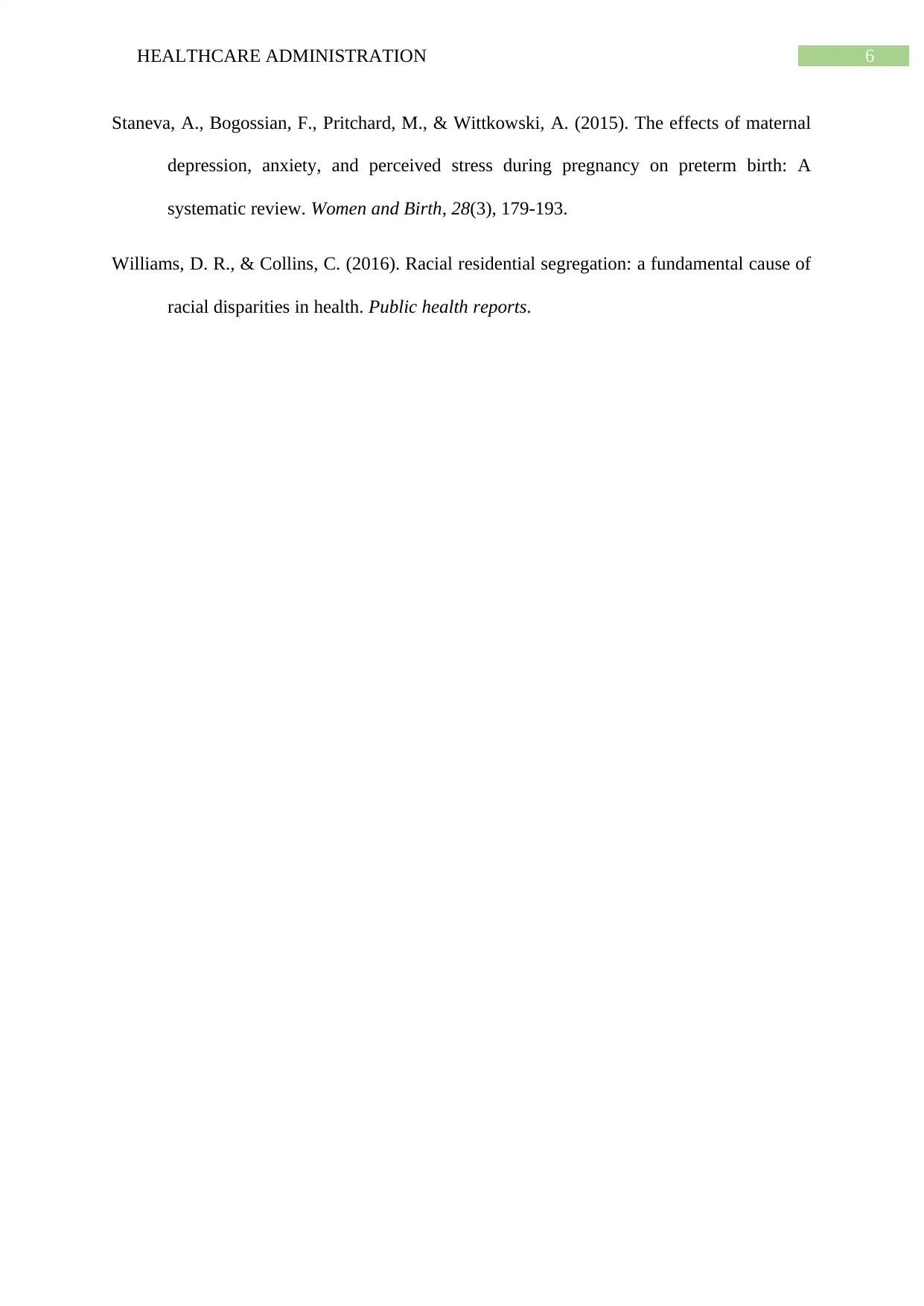
6HEALTHCARE ADMINISTRATION
Staneva, A., Bogossian, F., Pritchard, M., & Wittkowski, A. (2015). The effects of maternal
depression, anxiety, and perceived stress during pregnancy on preterm birth: A
systematic review. Women and Birth, 28(3), 179-193.
Williams, D. R., & Collins, C. (2016). Racial residential segregation: a fundamental cause of
racial disparities in health. Public health reports.
Staneva, A., Bogossian, F., Pritchard, M., & Wittkowski, A. (2015). The effects of maternal
depression, anxiety, and perceived stress during pregnancy on preterm birth: A
systematic review. Women and Birth, 28(3), 179-193.
Williams, D. R., & Collins, C. (2016). Racial residential segregation: a fundamental cause of
racial disparities in health. Public health reports.
1 out of 7
Related Documents
Your All-in-One AI-Powered Toolkit for Academic Success.
+13062052269
info@desklib.com
Available 24*7 on WhatsApp / Email
![[object Object]](/_next/static/media/star-bottom.7253800d.svg)
Unlock your academic potential
Copyright © 2020–2025 A2Z Services. All Rights Reserved. Developed and managed by ZUCOL.





